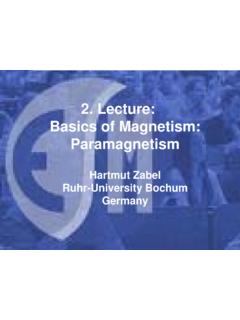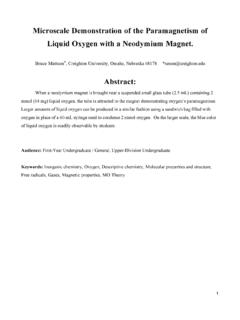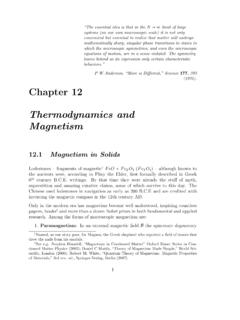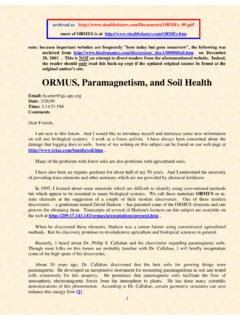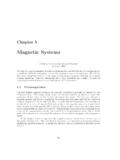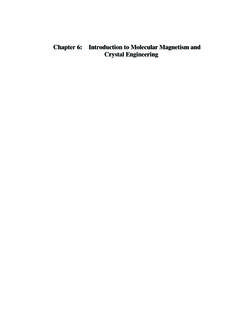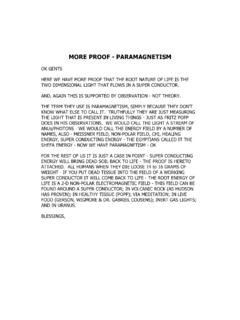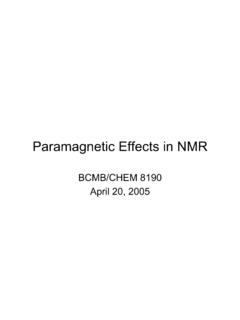Transcription of Superparamagnetic Materials - University of Ljubljana
1 Universityof LjubljanaFacultyofMathematics and PhysicsSeminar Ib 4th year (old program) Superparamagnetic materialsAuthor: Miha Marolt Advisor: Assoc. Prof. Dr. Zvonko Jagli ci cKranj, and applications of Superparamagnetic Materials , Materials composed of verysmall magnetic grains, are briefly presented. After a short introduction, theory describing asingle idealised grain is laid out and some magnetic properties of superparamagnets (FC andZFC curves,M(H) curve) are explained. There are many practical applications of superpara-magnetic Materials . For example ferrofluids are used for liquid seals, efficient heat transfer anddamping. Even more importantly, Superparamagnetic Materials play a major role in the harddisk drive technology. Various challenges related to thermal stability and writability stem fromthe ever decreasing size of magnetic grains. Currently four cutting edge HDD technologies thateither sidestep or solve problems related to magnetic grains are being developed: heat-assistedmagnetic recording, bit-patterned recording, shingled magnetic recording and helium filledHDDs.
2 E-mail address: Introduction12 A single grain .. A superparamagnet .. and FC magnetiza-tion curves .. distribution .. (H) ..43 Ferrofluids .. seals .. transfer .. HDD .. operation ..94 Conclusion101 IntroductionDefinitionA material is superparamagneticif it is made of very small single-domainnon-interacting magnetic1grains dispersed insome non-magnetic small isvery smalldepends on properties of magneticgrains. Typical value of their diameter is onthe order of 10 nm. Since properties of su-perparamagnetic Materials depend crucially onthe spontaneous magnetic moment of magneticgrains, it is implicitly understood that temper-ature is below the Curie or N eel temperature1In this seminar I use term magnetic in two differentbut related meanings. Sometimes I use it as a short-hand for ferri- or ferro-magnetic and sometimes I useit to signify a property of non-zero spontaneous mag-netization.
3 The first meaning is used when I talk aboutmagnetic grains and the second one when I talk aboutmagnetic material on HDD magnetic grains. It doesn t make senseto talk about superparamagnetism of nameAbove the so called block-ing temperatureTB, which is material andexperiment dependent (see Section ), su-perparamagnet can be described by the sameequations (details in Section ) that areused for ordinary paramagnet (ensemble ofnon-interacting magnetic moments with en-ergyE= Bwhen put in magnetic fieldB),the only difference being that magnetic mo-ments of individual particles are much largerin the case of superparamagnet (single atomsvs. grains composed of 1000s of atoms). There-fore magnetization curveM(H) of a super-paramagnet is similar to that of a paramagnet,but much steeper (higher susceptibility). Thisis the reason for the s magnetizationcurveM(H) has hysteresis and is thus moresimilar to ferromagnet s magnetization and applicationsSuper-paramagnetic Materials play an important rolein many areas of technology.
4 In this seminarI will take a closer look at superparamagneticmaterials in hard disk drives (HDDs) and atferrofluids. In hard disk drives information is storedby magnetizing small pieces of magneticmaterial on the platter. The former iscomposed of magnetic nanograins. Ferrofluids, which are a colloidal liquid ofnanoscale magnetic grains suspended in acarrier liquid, are used for liquid seals ( HDDs), efficient heat transfer ( inloudspeakers), in suspension systems andin various medical applications. They alsolook nice when put into vicinity of a per-manent magnet (Figure 4).1 Superparamagnetic Materials are also foundin nature in various rocks and living organ-isms [1]. Some companies even sell magneticnanograins extracted from horse spleen (that isnot the primary way of production though) [2].2 PropertiesFirst we will take a look at the theory de-scribing a single magnetic grain.
5 Then someproperties of superparamagnets will be pre-sented and explained in terms of properties ofa single A single grainLet s for the sake of simplicity assume thefollowing: Grain is composed of a single ferro- orferri-magnetic domain and its Curie orN eel temperatureTCis higher than tem-perature we are observing the grain conditions are rather mild sincemany Materials with domain sizes on theorder of m 10 nm and withTC Troomexist. Grainhasonlyuniaxialmagneticanisotropy, which means that there aretwo easy directions of magnetization2pointing in opposite directions. We needgrain with some magnetic anisotropy, sothat it can hold its magnetization, anduniaxial is the simplest one and it usuallydominates [2].Energy of a single-domain magnetic grainwith uniaxial anisotropy in external magnetic2 Easy direction of magnetization is an energeticallyfavorable direction of spontaneous magnetization thatis determined by the magnetic anisotropy [4].
6 Whenanisotropy is uniaxial, there are two easy directions ofmagnetization that point in opposite directions alongthe easy sum of its magnetic anisotropy andZeeman energies [18],E=KVsin2( ) 0 MsV Hcos ,(1)whereVis the volume of a grain,Kis uni-axial anisotropy parameter andMsis satura-tion magnetization. External magnetic fieldH, grain s magnetization and easy axis of mag-netization all lay in the same plane. is the an-gle between magnetization and magnetic field,while is the angle between easy direction ofmagnetization and magnetic the sake of simplicity lets make exter-nal field parallel to easy axis of magnetization, = 0. Dependence of energy on angle be-tween grain s magnetization and its easy direc-tion of magnetization (which by our simplifica-tion equals direction of external magnetic field)is shown on Figure 1: Schematic dependence of grain s en-ergy on angle between its magnetization andeasy direction of magnetization.
7 Dependenceis calculated from Equation (1). Source of fig-ure: my own see that in absence of external magneticfield there are two energetically equally favor-able directions (see blue curve on Figure 1).2 They are both parallel to easy axis of magneti-zation and between them is energy barrier Eof sizeKV. If temperature is high enough,thermal energykTcan overcome the barrierand grain s magnetization changes magnetic field breaks the symme-try between the two magnetizations along theeasy axis (see red curve on Figure 1). Energyof a grain is lower when magnetization pointsalong the external magnetic field than when itpoints in the opposite direction. Also energybarrier for jumping from magnetization alongthe external field to magnetization opposite toexternal field is much bigger than for the thermal fluctuations of the magneti-zation direction between the easy directionsare calledsuperparamagnetic (N eel) relaxationand typical time between the flops is givenby the N eel-Brown expression = 0e EkT,where 0is usually between 10 12s and 10 9s.
8 0depends weakly on temperature and var-ious material parameters such as magneticanisotropy constant, particle volume and satu-ration magnetization. [2]The measured magnetization of the grainwill depend crucially on the timescaletexpofthe experiment. Iftexp , the magnetiza-tion will appear static, while iftexp , theaverage value will be measured (in absence ofexternal field this will be 0). In practice thetwo regimes are classified in terms of temper-ature instead of time. Ablocking temperatureTBis defined [2]; it is the temperature at whichthe relaxation time equals the experimenttimescaletexp. Note that the blocking temper-ature is not uniquely defined for a given ma-terial, because it depends on timescaletexpofthe experimental technique A superparamagnetIn practice one usually deals with matterthat is composed of a large number of mag-netic grains. Let s investigate some propertiesof such ZFCandFCmagnetizationcurvesThese two curves are noteworthy becauseit is easy to estimate two important prop-erties (blocking temperature and strength ofinteraction between particles) of a monodis-perse sample just by quickly looking at thegraphs of temperature dependence of suscep-tibility (T).
9 The dependence (T) in both ZFC (zerofield cooled) and FC (field cooled) case is mea-sured during heating of a sample in small ( ) external magnetic field. Curves aredifferent because samples have different initialstate. In the ZFC case, the sample was pre-pared for measurement by being cooled fromsome high temperature (T TB) in absence ofexternal field. In contrast, the FC sample wascooled in non-zero external magnetic field [2].An example of FC and ZFC curves is shown inFigure low temperatures, susceptibility mea-sured in the ZFC case is small, because thetimescale of the experiment is too short forthe sample to reach thermal equilibrium valueof magnetization determined by canonical dis-tribution. At thermal equilibrium the ratioof particles with magnetic moment in direc-tion of external field to particles with mag-netic moment in direction opposite to externalfield (all other orientations are also possible,but it s easier to illustrate the idea by limit-ing to only two opposite directions) is propor-tional toe EkT, where Eis energy differencebetween the two orientations.
10 At high temper-atures susceptibility is low because the value of3050100150200250300350T (K) (m3kg 1)1e5 FCZFCF igure 2: ZFC and FC curves for sample ofmaghemite ( Fe2O3) magnetic grains withaverage diameter of 8 nm that are coated witholeic acid and dispersed in carnauba wax. Thedependant variable on the plot is mass suscep-tibility, = mH. Mass fraction of maghemitegrains is %. Blocking temperature can beestimated as the position of ZFC maximum it s about 46 K. Source of figure: my own in thermal equilibrium is small(again, proportional toe EkT).The peak isreached somewhere in between and it turns outthat maximum for a monodisperse sample is shape of FC curve is different from ZFCcurve belowTBas during the cooling processin magnetic field the system has enough timeto reach equilibrium magnetization. Also itsshape forT < TBtells us how much interac-tion there is between grains. If the interac-tion is negligible, susceptibility will be approx-imately proportional to 1/T(Curie s law) as inFigure 2, while if the interaction is large, sus-ceptibility will saturate at low Size distributionIn many applications, for example in HDDs,one wants grains as uniform in size as possi-ble.

